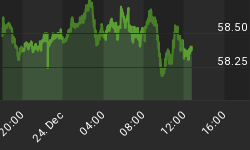The Large Cap Party
With gold knocking on $900 per ounce, most gold stock indices are making large advances despite an overly bearish sentiment on the broad equity markets. Large inflows into gold and silver ETFs are highlighting the point that there is major demand for stagflation insurance, namely gold and silver.
Institutionals seem to have a voracious appetite for large gold producers in early 2008. Barrick Gold, Newmont Mining, Goldcorp and Gold Fields make up around 60% of the S&P/TSX Global Gold Index ($SPTGD on the chart below), as well as other highly followed indices such as the Gold Bugs Index ($HUI) and Philadelphia Gold & Silver Index ($XAU). All have made impressive gains on large volume and a ton of block trading, which are signs of major institutional involvement.
In today's markets, it is becoming increasingly difficult to find companies with solid earnings growth. With the earnings reporting season just around the corner, precious metals producers are expected to report large improvements in profits. Sharply rising gold price is more than compensating for the increases in mining costs and decreases in production.

No Evidence of Gold Rally on Small Caps
The picture for the small / micro cap gold and silver stocks is much less rosy. The main index for these speculative exploration and development companies is the S&P/TSX Venture Composite Index ($CDNX). The ratio between $CDNX and $SPTGD is now falling to a low set in 2004 as investors seem to be repulsed by these leveraged gold plays. What are the reasons behind this disparity between producers and junior exploration companies?
- While producers are expected to report soaring profits, the exploration and development plays are expected to report more losses. Projected mining costs are going to be revised upward; capital expenditures for bringing projects into production will increase as well. The question is not if the costs will rise, but by how much. Additional delays in project development schedule will be commonplace as engineering firms and assay labs are unable to keep up with soaring demand for their services.
- Investors continue to be wary of the volatility in the juniors after a bloody washout in August and another in December. Volume has fallen on many small caps and a number of trades per day can often be counted on one hand.
- Sentiment exhibited by retail investors is at the most depressed level in years. In the American Association of Individual Investors survey (AAII), only 26% of investors expressed bullish views, while 55% expressed bearish views. With such negative views of the market, the last thing investors want to do is lose more money in the volatile development and exploration shares.
Even the "blue chip" exploration and development companies, which have been combined by Resource Stock Guide into a World Class Deposit Index, are not performing up to par. Stocks included in this index have the largest undeveloped gold, silver and uranium deposits in the world. They are prime targets for acquisition by major companies, yet they have underperformed the $HUI index by a wide margin since last summer.

Turnaround on the Way
The factors enumerated above are preventing investors from jumping on the exploration and development value plays. But this will change:
- Both general investor sentiment and the sentiment of exploration and development stock investors is so low today that it not likely to get any worse. What this means is that another washout is unlikely.
- Tax selling, a negative force in the latter part of 2007, is no longer a factor.
- Crisis of credibility prompted by Novagold and Southwestern Resources disasters has almost run its course, and junior exploration companies are reacting with better reporting and disclosure.
- The Securities and Exchange Commission (SEC) is relaxing its rules for investments in foreign stock markets by US investors. Under a proposal being prepared by the SEC, stock exchanges outside the US will be able to provide direct trading access to US investors through US-based brokers for the first time. This will greatly improve appeal, exposure and liquidity for many junior exploration and development companies traded on the Canadian stock exchanges.
- In the past several months, valuation levels for large and mid-size producers have increased. On the contrary, junior exploration and development companies have actually gotten cheaper in this time period. The valuation gap between producers and junior exploration companies is the widest it has been in years. Capital-rich but resource-hungry producers will not miss this opportunity.
A takeover frenzy is coming and it will push exploration and development stocks much higher.
















